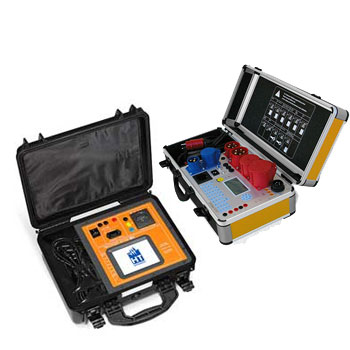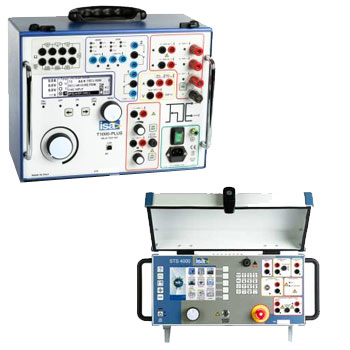
In many production environments, regular calibrations are essential to ensure the compliant use of measuring instruments and to maintain product quality. At the same time, calibration processes are increasingly under pressure to be efficient: machine downtimes, tight schedules, and a shortage of skilled workers make every minute count. Especially in serial production or highly automated systems, excessive calibration time can lead to production delays and unnecessary costs.
Typical challenges in daily practice include:
-
High time consumption in manual calibration procedures
-
User errors, for example due to complex menu navigation or error-prone manual valves
-
Long changeover times when switching between different pressure modules or measurement ranges
These factors negatively affect not only efficiency but also quality and process reliability. It is therefore all the more important to find solutions that specifically reduce calibration times – without compromising precision or traceability.
In this article, we demonstrate how the PV624 – in combination with quick module change and automated pressure control – can significantly reduce calibration time and the practical benefits it brings for users.
→ Requirements for efficient calibration processes
Calibration processes in industrial practice must meet high demands: on the one hand, results must be traceable, precise, and documented in compliance with standards. On the other hand, companies are under constant pressure to improve efficiency – especially when calibrations must be performed regularly during ongoing production.
Speed vs. Accuracy – a seeming contradiction?
Many users face the apparent choice between speed and accuracy. Manually performed calibrations are often error-prone, time-consuming, and require technical expertise. To save time, compromises are sometimes made in documentation or repeatability – which can lead to costly consequences during audits or due to quality deviations.
However, modern calibration systems show that speed and accuracy are not mutually exclusive when the process is systematically automated and the measurement technology is designed accordingly. The key is to ensure the calibration process is intelligently guided and reproducible – independent of the individual operator.
Flexibility with changing measurement ranges and sensors
In practice, the range of sensors to be tested is broad. Calibration equipment must therefore be capable of quickly switching between different pressure ranges and sensor types without requiring complex conversions or separate devices. A flexible calibration workstation should be able to cover a wide range of test scenarios – from vacuum to high pressure – and be easy to adapt.
The challenge: every module change or device swap costs valuable time and introduces potential sources of error. A fast, tool-free, and secure module change is therefore a crucial factor for efficiency and operational safety.
The role of automation in modern calibration processes
Automation is key to standardizing and accelerating calibration processes. Automated pressure control, automatic setpoint input, and software-supported test sequences reduce manual intervention to a minimum. This leads to:
-
Consistent process quality, regardless of the operator
-
Lower error rates and higher repeatability
-
Significantly reduced calibration time per sensor
-
Simplified documentation thanks to direct connection to calibration software
Modern systems like the PV624 address exactly these points and combine speed with precision – without compromise.
→ Solution in focus: PV624 with quick module change and automated pressure control
What is the PV624?
The PV624 is a powerful, electrically operated pressure supply module from Druck (Baker Hughes), designed for precise pressure generation in the range of vacuum to 100 bar (optionally up to 200 bar with an external booster). It is ideal for automated calibrations in industrial environments where speed, accuracy, and flexibility are essential.
As part of the Genii platform, the PV624 can be operated as a standalone unit or in combination with devices such as the DPI620G Genii or the PACE series. It supports both manual and fully automated test procedures – controlled via touchscreen, software, or external interfaces.

Key features focused on time savings
✅ Tool-free quick module change
The combination with PM620 pressure modules allows for the fast, tool-free replacement of sensors – ideal for changing pressure ranges in production. Thanks to the quick-release mechanism, modules can be changed within seconds without leakage or the need for re-adjustment.
Benefits:
- Calibration of multiple pressure ranges with only one base device
- No tools, no sealants, no lengthy conversions required
- Maximum availability with minimal setup time
✅ Automated pressure control to relieve personnel
The PV624 controls pressure fully automatically and with high precision. It can regulate to specific target values or follow automated pressure profiles – ideal for repeatable calibration routines. In combination with software such as 4Sight2 or the pressure controller PACE5000/6000, the entire process can be digitized and documented.
Technical highlights:
- Resolution: < 0.001% FS
- Stability: ±0.003% FS/year
- Pressure control up to 100 bar internally, expandable to 200 bar externally
- Minimal energy consumption and extremely quiet operation
Seamless integration and communication interfaces
The PV624 is modular and fully compatible with:
- DPI620G Genii (multifunction calibrator with touchscreen)
- PACE5000/6000 pressure controllers
- 4Sight2 calibration software for automated workflows and paperless documentation
In addition, the DPI620G can be flexibly integrated into existing systems using the following interfaces:
![]()
✅ HART communication (fully integrated with diagnostics)
✅ Profibus PA
✅ FOUNDATION Fieldbus
✅ Modbus RTU (via accessory module)
Suitable for hazardous areas (ATEX/IECEx) 
A major advantage in industrial practice: The DPI620G Genii and the associated pressure modules and power supplies are approved for use in hazardous areas (Zone 1 / Zone 2):
- ATEX, IECEx, CSA, INMETRO certified
- Device classification: Ex II 2 G Ex ib IIC T4 Gb
This means calibration can be performed directly in the field – without complex release procedures or explosion-proof enclosures.
Summary: Key benefits at a glance
| Feature | Benefit |
|---|---|
| Quick module change | Drastically reduces setup time |
| Automated pressure control | Saves time, reduces errors |
| HART & fieldbus interfaces | Ideal for smart transmitters |
| Ex approval | Safe use in Zone 1 |
| Integration with 4Sight2 & PACE | Fully automatable |
| Modular design | Scalable and future-proof |
→ Practical example: Time savings compared to conventional systems
How big is the difference between traditional manual calibration and an automated system like the PV624 in combination with DPI620G Genii and 4Sight2? The answer is best illustrated by a real-world comparison.
Comparison: Manual vs. automated calibration
| Aspect | Manual Calibration | Automated Calibration with PV624 |
|---|---|---|
| Pressure generation | Manual via hand pump or fine valve | Electronically regulated, fully automatic |
| Setpoint input | Manual, often imprecise | Controllable via touchscreen or software |
| Stabilization | Time-consuming, operator-dependent | Fast and repeatable |
| Module change | Requires tools, seals, adjustments | Quick-release (PM620) |
| Data acquisition | Manual, often on paper | Digital and traceable (e.g., via 4Sight2) |
| Personnel binding | High – continuous supervision required | Low – monitored automation possible |
Example: Calibration time per sensor before and after system upgrade
A mid-sized device manufacturer calibrates approximately 20 pressure sensors per day with varying measurement ranges. Before introducing the automated system, the average time per sensor was around 18 minutes – including setup, pressure generation, stabilization, and documentation.
After switching to the PV624 with automatic pressure control, quick module change, and software-assisted workflows, the average time is now just 6 minutes per sensor.
Result:
- Time savings of approx. 67% per calibration
- At 20 sensors per day, this saves around 4 hours per day
- Annually, this equals more than 1,000 hours of saved calibration time – with improved repeatability and reduced error rates
Field feedback
Users also report the following positive effects:
- Lower training effort thanks to intuitive operation
- Improved auditability due to digital data recording
- Fewer user errors, especially in complex pressure ranges
- More process safety through automatic test profiles
A maintenance manager from the chemical industry puts it this way:
“Previously, a technician needed almost an entire day to calibrate a batch of 20 pressure transmitters. Today, the process runs in the background – and the employee can focus on other tasks.”
→ Additional benefits for the user
In addition to significant time savings, using the PV624 in combination with devices such as the DPI620G Genii and the 4Sight2 software offers a variety of practical benefits that are noticeable in everyday operations – especially in terms of personnel, process quality, and workspace design.
✅ Lower training effort thanks to intuitive operation
Modern calibration systems like the PV624 are designed to be used efficiently even without deep metrology knowledge. The DPI620G Genii features a user-friendly touchscreen interface that significantly simplifies operation. Test procedures can be saved as standard profiles and reused at any time – minimizing not only training time but also error susceptibility in daily use.
Practical advantages:
- Quick onboarding of new staff
- Operation possible without specialized knowledge
- Error prevention through guided workflows
✅ Higher repeatability and process safety
Manual calibrations are inherently dependent on the individual operator – small deviations in pressure buildup, reading, or documentation can add up and compromise calibration quality. With automated pressure control and digitally stored test sequences, the PV624 ensures that every calibration process runs identically – regardless of who performs it.
Specific impacts:
- Reproducible measurement results, even with changing personnel
- Reliable proof of traceability for audits and ISO inspections
- Lower risk of faulty or non-compliant calibrations
✅ Reduced space requirements thanks to compact design
Space is a critical factor in many production areas – especially in mobile or decentralized test stations. Here, the PV624 stands out with its compact design: It is significantly smaller and lighter than traditional calibration setups with separate pressure sources, modules, and PC stations. All components – from pressure generation to sensors to control – can be combined modularly and installed in a space-saving way.
Result:
- Ideal for mobile calibration stations or tight maintenance areas
- Lower installation effort
- Easy to transport for field use (including Ex zones)
In summary, users benefit not only from faster workflows but also from increased safety, reduced training needs, and more flexible use – especially valuable in times of skilled labor shortages and rising quality demands.
→ Summary: Short calibration times without compromising quality
Efficient calibration processes are a key success factor in modern production. Reducing calibration times not only cuts costs and relieves personnel, but also increases productivity and process reliability. The PV624 in combination with the DPI620G Genii and the 4Sight2 software is a system that meets all these requirements.
Key advantages at a glance:
- Significant time savings through automated pressure control and quick module change
- High precision and repeatability with minimal error rate
- Intuitive operation – even for less experienced personnel
- Compact design for mobile or space-constrained applications
- Ex approval and support for all relevant communication protocols (HART, Profibus PA, Fieldbus)
The supposed contradiction between speed and accuracy is now a thing of the past. Modern calibration technology like the PV624 enables short calibration times – without compromising quality or traceability.
Our recommendation: An investment that pays off in the long term
Especially in times of labor shortages, increasing quality requirements, and growing automation, investing in high-performance calibration solutions is worthwhile. They relieve your staff, reduce sources of error, and free up time for value-adding activities – an investment that quickly pays for itself.











































































































































































